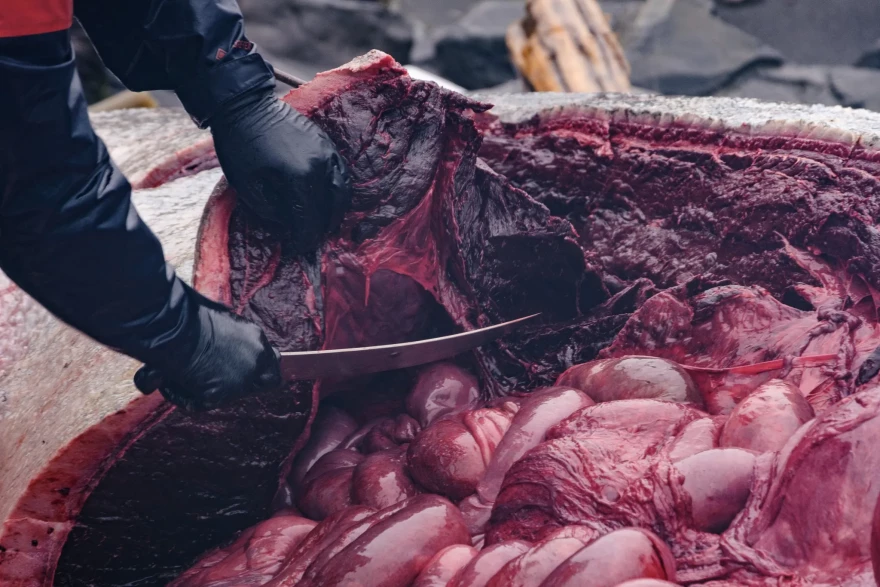Editor’s Note: Some photos depict blood and whale organs being removed.
Beaked whales are a rare sight and spend most of their lives deep in the ocean. But one was found dead on a beach near Kodiak last week.
The washed up whale’s corpse was a short hike along the Fossil beach and across a shallow creek on the shore.
It was most likely an adult male Cuvier’s beaked whale, just one of over 20 species of beaked whales.
Matt Van Daele is the natural resources director at the Sun’aq Tribe in Kodiak.
“It’s pretty ripe,” Van Daele said on Feb. 17. “(I’m) not sure how long it’s actually (been) located on the beach, but it probably was floating for a while and you can see a lot of scavenging, post-mortem bite marks.”
This is the third whale to wash up near the city of Kodiak in the last six months. A humpback whale was found in Chiniak Bay in September, and a fin whale was found just a few miles from this beaked whale near Pasagshak in late November. Both were emaciated, and in poor health.
But Cuvier’s beaked whales have a different food source. Beaked whales eat things like squids, while humpback and fin whales eat smaller animals like plankton. And unlike the filter feeders found dead last year, the team of scientists found that this whale was probably healthy before it died.
“There was no obvious external signs indicating a potential cause of death,” Van Daele said. “It appeared to be very healthy – the blubber looked healthy, the muscles looked healthy, it had a full stomach of squid beaks and fish vertebra so it definitely didn’t starve to death.”
Biologists estimate this kind of whale can hold its breath for up to three and a half hours. Van Daele said it’s possible this whale got caught in old fishing gear and drowned before it got untangled and drifted towards Kodiak.
Cuvier’s beaked whales are seldom seen – their habitat is normally far from shore. They can even be found 10,000 feet underwater. That’s about half as deep as Denali is tall.
Van Daele said their lack of time near the surface and shore makes this type of whale hard to study.
“It’s really a fascinating opportunity to be able to get up close and try to better understand this sea creature that’s so mysterious,” he said.
It’s Van Daele’s first time studying a beaked whale like this.
“The thing that surprised me the most was that it really didn’t smell that bad at all, and this was the first full necropsy I’ve been able to do on a beaked whale,” he said. “The only other one was pretty far gone, we didn’t have very much time at all to investigate it.”
The last beaked whale Kodiak scientists got to study was almost two years ago, near Afognak, on the northern end of the archipelago.
The team ended up taking samples from the whale’s stomach. They also saved some fins, and took its head and skull.
Van Daele said the team will probably take a few samples from the head for disease and genetics testing, but they also want to display the skull after the soft tissue rots away.
“We will rearticulate it. What I’m actually thinking is try to do half of it is the skull, and the other half is like the actual beaked whale itself,” he said.
Van Daele said he hopes it can be a tool to help teach people about the rare whales and that he’s grateful for the public reports that lead to the necropsy.
“The main reason that our marine mammal response program is so successful here is because of the public and our volunteers,” he said. “And especially just the interest that the public has in letting us know when there’s something weird going on or anything marine mammal related going on.”
Van Daele said his team’s next training to improve responses to marine mammal injuries could be as soon as May.
Research labs have a long backlog before they’ll get to the Kodiak beaked whale samples. Van Daele said he’s unsure what the results will show since the whale has been rotting for so long.
See full photo essay from the day on KMXT's website.




